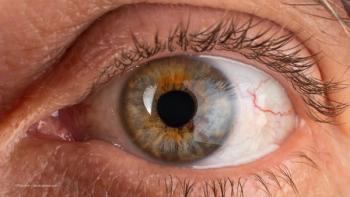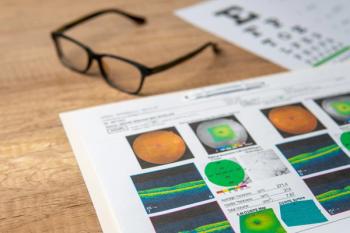
- December digital edition 2020
- Volume 12
- Issue 12
How to manage orbital fractures
Know orbit anatomy and how and when to image ocular trauma
Orbital fractures are a common result following trauma, often due to motor vehicle accidents, sports-related injuries, falls, or assault. While ophthalmologists are often consulted to evaluate trauma patients, optometrists are less likely to have experience with these cases.
This article will familiarize readers with orbital fractures by reviewing clinical examination techniques, demonstrating common imaging findings, and providing guidance on imaging and referral patterns.
Anatomy of the orbit
Four walls form the boundaries of the orbit. The floor of the orbit is formed by the maxillary bone, palatine bone, and orbital process of the zygomatic bone. The infraorbital canal passes within the floor, and the bone medial to it is thin and susceptible to fracturing.
The largest paranasal sinus, the maxillary sinus, lies directly below the orbital floor. The medial wall is formed by the maxillary bone, ethmoid bone, lacrimal bone, and lesser wing of the sphenoid. The lamina papyracea, translated from Latin as “thin wall,” is part of the ethmoid bone and is the thinnest bone of the orbit.
The medial wall possesses small anterior and posterior ethmoidal foramina that pierce through the wall and communicate with the adjacent ethmoid sinus. It is through this tract that infections may spread from the sinus into the orbit.
The orbital roof divides the orbit from the anterior cranial fossa and is composed of the frontal bone and the lesser wing of the sphenoid. Finally, the lateral wall of the orbit is comprised of the zygomatic bone and greater wing of the sphenoid.
Patient presentation
When a patient presents with a history of periorbital trauma, the globe must first be thoroughly evaluated for evidence of injury. Trauma severe enough to fracture an orbital wall may present with findings such as iritis, iridodialysis, hyphema, vitreous hemorrhage, commotio retinae, retinal breaks, or in some cases, a ruptured globe.
Timely management of these ophthalmic findings is important for preservation of vision. Once the globe is evaluated in full, attention is directed to the orbital exam.
Clinical signs of orbital fractures
Patients who present with orbital fractures may complain of a multitude of symptoms including eyelid swelling, ecchymosis, pain, or double vision. While edema and bruising may be fairly common in ocular trauma, they are far from pathognomonic for orbital fractures.
Below are findings more commonly seen in orbital fractures.
Hypoesthesia
The infraorbital nerve arises from the maxillary division of the trigeminal nerve (cranial nerve V2). This nerve branch serves to provide tactile, temperature, and pain information from the midface (lower eyelid to upper lip), nasal cavity, teeth of the upper jaw, and palate. It passes through the infraorbital canal along the orbital floor and may be damaged in blow-out fractures, leading to hypoesthesia.
This can be evaluated by testing sensation on both sides of the face in the V2 dermatome and asking the patient to rate sensation (0 to 10) on each side.1 Unfortunately, the use of this technique may be limited in cases of bilateral or antecedent sensation loss. In those cases, consider inquiring about new onset numbness or loss of sensation in the upper teeth or lip. In cases of post-traumatic V2 hypoesthesia, imaging is warranted.
Diplopia
Double vision is a common symptom of orbital trauma and has been reported in 16 to 56 percent of cases of orbital fractures.2-5 Diplopia may be the result of direct muscle or periorbital tissue incarceration, traumatic hemorrhage and swelling of the orbital tissue, or direct damage to muscles, nerves, or vasculature.3-6
Comprehensive evaluation of extraocular motilities can be completed in office with an alternate cover test in primary, lateral, and vertical gazes. It is useful to gather quantitative measurements with prism bars to better describe and monitor ocular motility. Of note, patients may not complain of diplopia if they have significant eyelid edema obstructing the visual axis, so gently holding eyelids open during motility testing can be helpful.
Enophthalmos or exophthalmos
The position of the globe within the orbit is a valuable measure to obtain. When an orbital fracture is present, orbital tissue may herniate into the adjacent maxillary or ethmoid sinuses. This often leads to a relative enophthalmos of the affected eye. Notably, trauma can also lead to exophthalmos in cases of significant orbital swelling or hemorrhage.
In a report by Schönegg et al, ≥1 mm of enophthalmos was seen in 45.5 percent and exophthalmos in 9.1 percent of patients presenting acutely with an orbital fracture.5 Worth noting, a clinically significant exophthalmometry value is a difference of ≥2 mm between the right and left sides. This measure should be taken on any patient in whom you suspect an orbital fracture.
Enophthalmos may initially be concealed by inflammation but often becomes more apparent as swelling resolves. Patients presenting with exophthalmos, vision loss, and elevated intraocular pressure should be emergently evaluated for a retrobulbar hemorrhage, which can cause compartment syndrome of the orbit.
Imaging
When and what do I order?
Imaging should be obtained in cases of orbital trauma with findings of diplopia, reduced ocular motility, abnormal globe position, or V2 hypoesthesia. Patients presenting with nausea or vomiting, dizziness, and/or reduced heart rate should be referred and imaged emergently due to concern for entrapped tissue or a trapdoor fracture which may stimulate a potentially life-threatening oculocardiac reflex. Otherwise, contingent on a normal ophthalmic exam, patients should be referred for urgent, outpatient imaging.
In cases of suspected facial bone fractures, computed tomography (CT) is the preferred method of imaging over magnetic resonance imaging (MRI). A CT scan provides better resolution of the orbital and facial bones and is superior in visualizing small fractures or orbital emphysema.7 Additionally, MRI is typically less cost-effective, requires longer accession time, and is contraindicated in patient who have pacemakers, vascular clips, or suspected metallic foreign bodies.
For patients requiring imaging, a CT maxillofacial without contrast or CT orbit without contrast can provide excellent resolution of the orbit and paranasal sinuses. These study sequences are ideal when compared to a CT head because they provide smaller sections.
What do I look for?
When viewing CT images, it is beneficial to evaluate coronal, sagittal, and axial views individually. On an axial cut through the equator of the globe, one can often note the presence or absence of gross enophthalmos.
Next, assess the bone structure. Fractures may be described as displaced or non-displaced, depending on the fractured bone’s alignment with the adjacent bone.
Next, examine the extraocular muscles. The recti muscles are more likely to be impacted given their proximity to the orbital walls when compared to the oblique muscles. Compare the shape of the recti muscles on the affected side to the unaffected, with an asymmetric or an elongated contour suggestive of external forces on the muscle (due to a fracture or secondary process).
Intraorbital air, also known as orbital emphysema, is visible by a hypodense signal that appears as a black, rounded space. Another common feature visible on CT scans of orbital fractures is the presence of herniated tissue or blood into adjacent sinuses.
Case examples
Case 1
This male presented to clinic with a history of being punched in the right eye during a boxing match 4 days prior to presentation (Figure 1). He initially was asymptomatic, but the day prior to presentation, he sneezed and immediately developed significant right eyelid swelling.
A CT orbit study was ordered to evaluate for an orbital fracture given the acute onset of suspected orbital emphysema after a Valsalva-like maneuver. The sagittal (left) and coronal (right) views revealed preseptal and post septal air spaces (yellow arrows). There was a displaced medial wall fracture (red arrow), but the medial rectus muscle (blue arrow) demonstrated a normal course confirming there was no entrapment.
This patient did not require surgery, and the emphysema resolved spontaneously by the 1-week follow-up visit.
Case 2
This male sustained trauma to the right side of his face after a fall (Figure 2). He was symptomatic for diplopia and pain with eye movement.
A CT maxillofacial was completed and revealed a right-sided blow-out floor fracture (blue arrow). The inferior rectus was significantly displaced and rounded, extending into the maxillary sinus (yellow arrow). Orbital emphysema was also seen (red arrow).
This patient underwent urgent repair with the placement of an orbital floor implant.
Case 3
This female was involved in an altercation in which she was struck in the left eye (Figure 3). She complained of diplopia and pain on eye movement.
The CT revealed a displaced medial wall fracture with an entrapped medial rectus muscle (blue arrow). She was referred the same day to an oculoplastic specialist for evaluation and underwent surgical repair.
Case 4
This male was involved in a motor vehicle accident and sustained facial trauma (Figure 4). There was a fracture of the orbital floor with a very small pocket of adjacent air in the orbit (yellow arrow). Notably, debris is visualized in the left maxillary sinus but not in the right. On the lateral border of the maxilla, a displaced fracture is also seen (blue arrow)
This patient underwent urgent repair with an oral and maxillofacial surgery team due to the significant mid-face involvement.
Follow-up and referrals
When a patient is diagnosed with an acute orbital fracture, the management strategy consists of initial treatment, follow-up care, and possibly surgical intervention. In addition to advising cold compresses to reduce periorbital edema, patients who suffer a fracture should be warned not to blow their noses and should avoid situations which may increase their chances of sneezing. Any forceful Valsalva-like maneuver can increase the intranasal air pressure and allow for rapid gas entry into the orbit, leading to orbital emphysema. Orbital emphysema is largely self-limited, but severe complications like orbital compartment syndrome leading to vision loss have been described.8
Because orbital walls are shared with sinuses which can harbor bacteria, prophylactic oral antibiotics are commonly prescribed. Overall, there is a paucity of literature offering guidance on the efficacy of antibiotic prophylaxis.9 Despite the fact that orbital cellulitis after orbital fractures is uncommon, the use of prophylactic antibiotics is relatively high (42 to 70 percent) and varies significantly among treating specialties.10-12
Antibiotic use is likely of greatest benefit in the setting of trauma with residual foreign matter, active sinusitis, or an immunocompromised state. When prescribed, consider a short course of amoxicillin-clavulanate or cephalexin; they are the most commonly used antibiotics in these cases.10-12
It is important to recognize that not all orbital fractures will require repair. A growing body of literature suggests observation in certain circumstances, but these decisions are best determined on a case-by-case basis by the evaluating oculoplastic surgeon. Small fractures without diplopia or globe displacement, for example, are often monitored with return precautions advised. Non-emergent repairs should be performed within 2 weeks of the injury to prevent complications from scarring and tissue contracture.13,14
Common indications for repair include the following:
Persistent diplopia after edema subsides at 1 to 2 weeks
Positive forced-duction testing that indicates a tightly trapped muscle
Enophthalmos >2 mm not cosmetically acceptable to the patient
Significant early enophthalmos with a large floor fracture
Large (>50 percent of the wall) or complex, multi-bone fracture
Summary
Ocular trauma is common, and ODs should be familiar enough with orbital fractures to assess the need for imaging and referral. Understanding the relationships of the orbit, periorbita, and paranasal sinuses is critical when evaluating patients with suspected orbital fractures. This knowledge, along with a thorough and focused examination, should guide our prescribing, imaging, and referral patterns.
References
1. Strauch B, Lang A, Ferder M, Keyes-Ford M, Freeman K, Newstein D. The ten test. Plast Reconstr Surg. 1997 Apr;99(4):1074-8.
2. Boffano P, Roccia F, Gallesio C, Karagozoglu KH, Forouzanfar T. Diplopia and orbital wall fractures. J Craniofac Surg. 2014;25(2):e183-5.
3. Park MS, Kim YJ, Kim H, Nam SH, Choi YW. Prevalence of Diplopia and Extraocular Movement Limitation according to the Location of Isolated Pure Blowout Fractures. Arch Plast Surg. 2012 May;39(3):204-8.
4. Burm JS, Chung CH, Oh SJ. Pure orbital blowout fracture: new concepts and importance of medial orbital blowout fracture. Plast Reconstr Surg. 1999 Jun;103(7):1839-49.
5. Schönegg D, Wagner M, Schumann P, Essig H, Seifert B, Rücker M, Gander T. Correlation between increased orbital volume and enophthalmos and diplopia in patients with fractures of the orbital floor or the medial orbital wall. J Craniomaxillofac Surg. 2018 Sep;46(9):1544-1549.
6. Putterman AM. Management of orbital floor blowout fractures. Aesthet Surg J. 2018 Apr 6;38(5):488-490.
7. Freund M, S. Hähnel S, Sartor K. The value of magnetic resonance imaging in the diagnosis of orbital floor fractures. Eur Radiol. 2002 May;12(5):1127-33.
8. Roelofs KA, Starks V, Yoon MK. Orbital Emphysema: A Case Report and Comprehensive Review of the Literature. Ophthalmic Plast Reconstr Surg. Jan/Feb 2019;35(1):1-6.
9. Gheza C, Bravo-Soto G, and Varas G. Are postoperative prophylactic antibiotics effective for orbital fracture? Medwave. 2018 Jul 30;18(4):e7234.
10. Reiss B, Rajjoub L, Mansour T, Chen T, Mumtaz A. Antibiotic Prophylaxis in Orbital Fractures. Open Ophthalmol J. 2017 Jan 31;11:11-16.
11. Ben Simon GJ, Bush S, Selva D, McNab AA. Orbital cellulitis: a rare complication after orbital blowout fracture. Ophthalmology. 2005 Nov;112(11):2030-4.
12. Wang JJ, Koterwas JM, Bedrossian EH Jr, Foster WJ. Practice patterns in the use of prophylactic antibiotics following nonoperative orbital fractures. Clin Ophthalmol. 2016 Oct 27;10:2129-2133.
13. Lee S H, Lew H, Yun YS. Ocular motility disturbances in orbital wall fracture patients. Yonsei Med J. 2005 Jun 30;46(3):359-67.
14. Caranci F, Cicala D, Cappabianca S, Briganti F, Brunese L, Fonio P. Orbital fractures: role of imaging. Semin Ultrasound CT MR. 2012 Oct;33(5):385-91.
Articles in this issue
about 5 years ago
New ways to keep dry eye patients comfortable in contact lensesabout 5 years ago
ODs look back on 2020about 5 years ago
Cataract surgery 2020 updateabout 5 years ago
Long-term follow-up of angiod streaksabout 5 years ago
Can AI rescue physicians from EHR woes?about 5 years ago
How to handle dry eye follow-up visitsabout 5 years ago
Quiz: Know the ocular effects of eyelash growth serumsabout 5 years ago
Know the ocular effects of eyelash growth serumsabout 5 years ago
Quiz answers: Know the ocular effects of eyelash growth serumsabout 5 years ago
Navigate postop IOP control with wound burpingNewsletter
Want more insights like this? Subscribe to Optometry Times and get clinical pearls and practice tips delivered straight to your inbox.













































.png)


